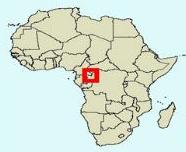 世界遺產大會7月1日於聖彼得堡召開年會,會中宣布新增六個自然遺產場址,其中包括棲息著大象、大猩猩、黑猩猩的剛果盆地熱帶雨林心臟地帶。這也是第一個跨越三個國家的世界遺產,稱為「桑哈跨三國保護區」(Sangha Tri-National Protected Area),共跨越剛果共和國、喀麥隆及中非共和國,佔地25000平方公里。
世界遺產大會7月1日於聖彼得堡召開年會,會中宣布新增六個自然遺產場址,其中包括棲息著大象、大猩猩、黑猩猩的剛果盆地熱帶雨林心臟地帶。這也是第一個跨越三個國家的世界遺產,稱為「桑哈跨三國保護區」(Sangha Tri-National Protected Area),共跨越剛果共和國、喀麥隆及中非共和國,佔地25000平方公里。
桑哈三國保護區的核心區是由桑哈河串連起的三個國家公園組成。2000年起,剛果共和國、喀麥隆及中非共和國同意為保育及永續使用此區自然資源共同努力。
 國際自然保護聯盟世界遺產計劃主任Tim Badman表示,「桑哈三國保護區是個具有良好保護前景的原始環境,許多極度瀕危的物種棲息期間。」
國際自然保護聯盟世界遺產計劃主任Tim Badman表示,「桑哈三國保護區是個具有良好保護前景的原始環境,許多極度瀕危的物種棲息期間。」
作為世界遺產自然遺產委員會的官方顧問,世界自然保護聯盟推薦桑哈三國保護區(通常以法文簡稱TNS稱之)的劃設。
桑哈三國保護區目前由國際野生物保育協會(WCS)、世界野生動物基金會、英國TNS信託基金會、聯合國教科文組織世界遺產中心、英國人猿生存協會、人猿生存夥伴計畫(GRASP)、美國、德國、法國、西班牙政府及其他私人捐助提供長期的技術及經濟支援。
TNS基金會執行主任Timothée Fomete表示「桑哈三國保護區列入世界遺產是對以中非森林委員會之整合計畫(COMIFAC)為架構,多邊合作成果的獎勵。有了來自三個國家的政府和捐助者的支持後,基金會將繼續提供這個美麗的世界遺產的融資。」
國際野生物保育協會非洲方案主任James Deutsch表示「桑哈三國保護區是剛果盆地雨林野性之心,它供給包含非洲森林象、大猩猩、黑猩猩及其他瀕危生物族群生存環境。我們為世界遺產大會認可這個區域為全世界共同的寶藏喝采、也為剛果共和國、喀麥隆及中非共和國的遠見祝賀。如同中非的其他地區,此區正受到不永續的資源開發、非法象牙貿易等事件威脅,我們希望名列世界遺產能為保存它注入新的能量。」
然而名列世界遺產並不完全保護具傑出普世價值的地區不受資源開採影響,世界遺產大會正在建立一套正式準則提供世界遺產世界遺產條約締約國,讓資源開採工業不得進入世界遺產點。
 世界野生動物基金會中非的地區代表Stefanie Conrad認為,該區已為進入世界遺產盡最大的努力。「這是包含保護區管理人員、三國中央政府、研究者、社區領袖、私人部門及金融伙伴共同努力十數年的成果,使桑哈三國保護區真正成為跨國世界級森林景觀運作的區域。世界遺產會將桑哈三國保護區引薦給全世界,吸引更多的支持來持續保護它世界級的生物多樣性及與它相依存的人們。」
世界野生動物基金會中非的地區代表Stefanie Conrad認為,該區已為進入世界遺產盡最大的努力。「這是包含保護區管理人員、三國中央政府、研究者、社區領袖、私人部門及金融伙伴共同努力十數年的成果,使桑哈三國保護區真正成為跨國世界級森林景觀運作的區域。世界遺產會將桑哈三國保護區引薦給全世界,吸引更多的支持來持續保護它世界級的生物多樣性及與它相依存的人們。」
桑哈三國保護區是赤道非洲最少人類足跡的區域之一,它的熱帶森林、濕地及天然林間空地「拜斯(bais)」吸引了數個大猩猩家族,另有成千上萬的鸚鵡棲息。
 拜斯是野生動物社交及基因交流的特殊場域,只有在拜斯 可以經常看到超過100頭森林大象聚集,有時還會有其他大型哺乳動物諸如森林水牛、叢林巨豬、邦戈羚羊及林羚等出沒。
拜斯是野生動物社交及基因交流的特殊場域,只有在拜斯 可以經常看到超過100頭森林大象聚集,有時還會有其他大型哺乳動物諸如森林水牛、叢林巨豬、邦戈羚羊及林羚等出沒。
桑哈三國保護區核心區面積7542平方公里,由分屬鄰近三國的國家公園組成。緩衝區面積17880平方公里,是擇伐區,多數由森林管理委員會認可為永續伐木。緩衝區還包含了中非共和國特別森林保護區,農業、打獵、伐木及旅遊狩獵等行為在此區是被許可的。
世界遺產名單包括了957個受到世界遺產委員會認為具傑出普世價值者的文化及自然世界遺產點。這些分佈於155個國家的點位包括739個文化遺產、189個自然遺產及29個複合遺產。2012年三月,193個各國政府中的189個批准了世界遺產公約。
The heart of the Congo Basin rainforest where elephants, gorillas and chimpanzees still survive was named a World Heritage Site Sunday by the United Nations Education, Science, and Cultural Organization, UNESCO.
The first World Heritage site that spans three nations, the Sangha Tri-National Protected Area complex covers 10,000 square miles (25,000 km2) stretching across the Republic of Congo (Brazzaville), Cameroon, and the Central African Republic.
At its annual meeting in St. Petersburg, the UN World Heritage Committee declared the site would be added to its list along with five other natural sites of outstanding universal value.
The World Heritage Site declaration marks the culmination of a vision dating from 2000 when the three countries agreed to work together to assure conservation and sustainable use of natural resources of the area.
The core of the Sangha Tri-National Protected Area is formed by three adjoining national parks connected by the Sangha River.
"Sangha Trinational is not a fragment but part of a much larger intact environment with good conservation prospects, and harboring critically endangered species," said Tim Badman, director of the World Heritage Programme of the International Union for the Conservation of Nature.
In its role as official advisor to the committee on natural sites, the IUCN recommended designation of the Sangha Tri-National Protected Area, usually called by its French acronym, TNS.
The TNS already benefits from long-term technical and financial support from the Wildlife Conservation Society, World Wildlife Fund, a UK-registered trust fund called the TNS Foundation, UNESCO's World Heritage Centre, the UN Great Apes Survival Partnership, GRASP, and the governments of the United States, Germany, France and Spain, as well as private donors.
Timothée Fomete, executive director of the TNS Foundation, said, "The TNS recognition as a World Heritage Site comes as a reward to a multi-partnership approach fostered by the foundation within the framework of the Central African Forest Commission, COMIFAC. This decision raises the profile of TNS as well as expectations on the urgency of an integrated conservation and development approach. With the support from the three country government and donors, the Foundation will continue to contribute to the sustainable financing of this beautiful World Heritage site."
"The TNS is the wild heart of the Congo Basin rainforest," said James Deutsch, Wildlife Conservation Society's director of Africa Programs. "It contains some of the last great populations of African forest elephants, gorillas, chimpanzees, and other endangered species."
"We applaud the World Heritage Committee for acknowledging the area as a global treasure and congratulate the governments of the Republic of Congo, Cameroon, and Central African Republic for their foresight," said Deutsch. "As everywhere in Central Africa, this global treasure is under threat from unsustainable resource extraction, including the illegal ivory trade, and we hope that the TNS's listing will re-energize global efforts to save it."
While listing as a World Heritage site does not completely protect areas of Outstanding Universal Value from resource extraction, the committee is in the process of developing a set of formal guidelines for countries that are Parties to the World Heritage treaty to keep extractive industries out of World Heritage sites.
Stefanie Conrad, regional representative of WWF for the Central Africa region, recognizes all the effort that has gone into achieving a World Heritage declaration for the area. "This inscription is the culmination of over a decade of work by many dedicated people, ranging from protected area managers, central governments in the three countries, researchers, community leaders, private sector and financial partners to make the TNS a truly functional trans-boundary managed world class forest landscape."
"This World Heritage status will introduce the TNS to the rest of the world and lead to increased support for the continued protection of the area's globally important biodiversity and for the people that depend on it," Conrad said.
The TNS has one of the lowest human footprints in equatorial Africa. Its tropical forests, wetlands, and natural forest clearings known as "bais" attract multiple gorilla groups simultaneously, while others host thousands of parrots.
The bais are exceptional hubs for social and genetic exchanges for wildlife. Only there do more than 100 forest elephants so often congregate, sometimes with other large mammals such as forest buffalo, giant forest hogs, striped antelope known as bongo and swamp-dwelling antelope called sitatunga.
The new World Heritage Site is made up of a core 2,911 square miles (7,542 km2) area consisting of Dzanga-Ndoki National Park in Central African Republic, Lobéké National Park in Cameroon, and Nouabalé-Ndoki National Park in the Republic of Congo.
An additional 6,903 square miles (17,880 km2) buffer zone is managed for selective logging operations, many of which are certified by the Forest Stewardship Council as logged sustainably.
The buffer zones include the Dzanga-Sangha Dense Forest Special Reserve in Central African Republic, a multiple use area where agriculture, hunting, logging and safari hunting are permitted. There are five logging concessions bordering the Nouabalé-Ndoki National Park and a series of logging and community-use zones in Cameroon.
The World Heritage List includes 957 properties forming part of the cultural and natural heritage which the World Heritage Committee considers to have outstanding universal value.
These include 739 cultural sites, 189 natural sites and 29 mixed cultural-natural properties in 155 countries. As of March 2012, 189 of the world's 193 governments had ratified the World Heritage Convention.





